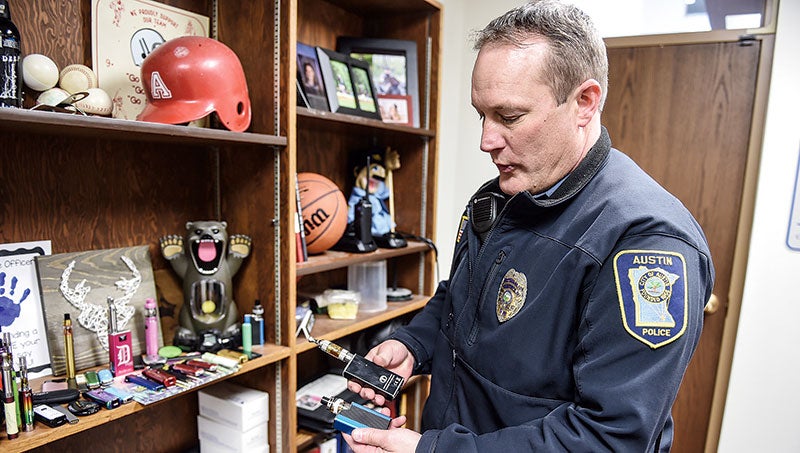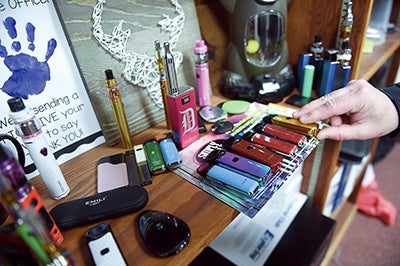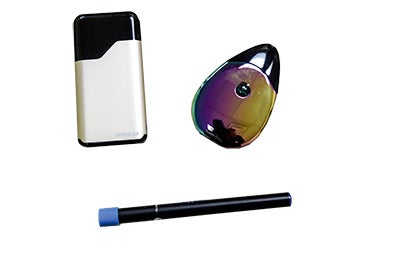Where there’s smoke: Austin Public Schools tackles vaping, e-cigarette usage
Published 1:04 pm Sunday, March 3, 2019

- Austin Police officer and school resource officer Jim Lunt, is one of two SROs within the Austin public Schools District. Herald file photo
When encountering underage vaping at Austin High School, Austin Police officer Jim Lunt knows firsthand how big the issue is.
“It’s absolutely horrible, it’s an epidemic at the high school,” Lunt said. “It doesn’t matter if you’re an athlete, good student, horrible student. They’re all vaping. There isn’t a week that doesn’t go by whether I take a vape device myself or it’s administration taking vapes off of students. It’s an epidemic.”
During the school week, Austin High School’s school resource officer ends up confiscating anywhere between five and seven vaping devices per week. Sitting on a shelf in his office, Lunt has accumulated between 25 to 30 vaping devices of varying sizes and colors to hold as evidence.
Since e-cigarettes or vaping pens are considered to be an explosive device, he eventually destroys them after gathering everything he needs. If a student was caught underage with a smoking device, Lunt will issue a citation for that student.
“My office smells like one big vape,” he said. “We gotta keep it as evidence. Vapes are dangerous and you don’t log them into the system as evidence because they’re an explosion hazard. They end up sitting on my shelf until I have to destroy them and properly dispose of the battery.”
While out doing rounds in the school, Lunt usually can tell if there’s something amiss, such as when a large group of people heads off into the bathrooms or there’s a pleasant odor of fruit or mint coming from areas where there are no cameras.
“What we’re not seeing is the cigarettes and not really seeing chewing tobacco, it’s straight up vapes,” Lunt said. “Students think they’re so smart, but they’re not. When you see 10 boys going into the bathroom, you know something’s up. One person or two or three go into an area where it isn’t on camera to vape, they pass it around and take a few hits with it. A teacher or administrator will walk into a bathroom and that’s how we catch them. If the school has enough probable cause, then students get searched and they find it that way.”

Ausitn Police officer Jim Lunt has in his office at Austin High School and assortment of vaping devices he has confiscated from students. Eric Johnson/photodesk@austindailyherald.com
A smoky reality
Within Mower County, traditional cigarette smoking has decreased by 50 percent, according to Chris Weiss, Mower County community health specialist. On the other hand, vaping has increased by 70 percent, with 85 percent of those e-cigarette/vape users between the ages of 12 to 17, using the devices because of the different flavors.
To gather data, Mower County used statistics from the MN Student Survey, SHIP County Surveys, MN Adult Tobacco Survey and the Austin Positive Coalition Student Survey. The most recent survey from 2016 (another survey will be finished later this year) stated that 10.4 percent of freshman admitted they use e-cigarettes and 12.2 percent of juniors said they used e-cigarettes. Those same freshman also reported that 13.6 percent of them used some sort of tobacco and 15.7 percent of juniors used some sort of tobacco.
“There are over 15,000 different e-juice and flavor pods on the market,” Weiss said, noting these flavors are more appealing to youth as opposed to the traditional combustible cigarette. “Social media is also not helping the situation as adolescents find that it is like a game to try to not get caught while vaping in class or in front of adults.”
E-cigarettes and vaping products at the lower grade levels is also making its rounds, but not on the same scale as what’s being encountered at the high school.
Officer Brian Blake, the school resource officer for Ellis Middle School and IJ Holton Intermediate School, has confronted “a half-dozen” students in the lower grade levels with e-cigarette and vaping devices. He’s received calls about finding students vaping in restrooms or even on the school bus.
“I wouldn’t call it a growing issue,” Blake said. “I know Officer Lunt has had run-ins over at the high school, too. I’ve seen it here and IJ has seen it. The administration and staff are doing a great job talking to parents and kids and letting them know what’s going on.”
Typical devices that Blake has encountered during his confrontations would be items that could be confused for everyday items like a zip drive. Some devices charge via USB ports, and could easily be misidentified as a flash drive, making confiscating items more difficult.
“If there’s a way a kid can get it, a kid can get it,” he said. “Some of these are starting to look like a zip drive, and parents and teachers are becoming informed.”
One way that underage students may have access to these devices could be through an older sibling, Lunt said. He has received a call from one of the elementary schools in the district, where a young student brought a vaping device to school, possibly getting impressioned by how older students act.
“Young kids see it too,” Lunt said. “They’re seeing older people, brothers and sisters, blowing vape out of their mouth. They get intrigued and want to try it. Kids don’t think it’s bad, and that’s where the problem is. They don’t realize what they are inhaling are chemicals. They don’t realize the nicotine they’re taking in and they’re going to get addicted.”
As to whether he felt that parents were aware of vaping devices and the ramifications, Lunt said there was more information provided to the district, but the knowledge about long-term health effects and vaping is still relatively new.
“You know, I deal with parents who allow vaping for whatever reason,” he said. “Maybe the parent doesn’t realize the health risks in the long term.”
Back when JUUL-brand devices first came out, they were larger and easier to identify. Now, there are pocket sized devices and individuals have the ability to purchase various types of vaping products, including tetrahydrocannabinol (THC) capsules, and bring them back to Austin.
“I’ve got two sitting here, vape pens, with THC oil or capsules that got taken out of the high school,” Lunt said. “THC is legal to buy in other places and now we have that in the high school. That’s gonna absolutely destroy kids. Think about it, five kids and they all take one hit of THC vape, they’re gonna get stoned. It’s very potent stuff. These are things students aren’t aware of as far as the level of THC. That’s gonna get scary.”
One way that Lunt and Blake tried to curb the usage was by educating parents, teachers and students on the risks of vaping and informing them about the new variety of devices hitting the market.
Lunt goes around to health classes at the high school to discuss drugs and alcohol, and within recent years, vaping has entered those discussions.
“I usually ask students to be honest and to raise their hands if they have ever used e-cigarettes or vaped,” he recalled. “Hands that are raised are usually 75 to 85 percent of the class. It surprises me every time.”
Starting a dialogue
The district has been working on training staff and informing families about vaping. Blake noted that he often worksd closely with administrators in updating them when a new device hits the market and to know what to look for when they suspect a student is vaping at school.
“I think it’s a good starting point,” Blake said. “We’re starting to get them aware of what this can do to them.”
There are also active conversations happening with students about the dangers of vaping, and what health effects can stem from vaping. Starting with education, the public can become more informed on the relatively new method of smoking and its effect on younger students.
While traveling to other area school districts to share information about vaping, Weiss shared that certain chemicals in vaping can be found such as acrolein (a chemical that can cause irreversible lung damage), formaldehyde, a cancer-causing chemical, and toxic metal particles like chromium, lead and nickel.
“Some adolescents don’t know that there is nicotine in these juices or pods,” she said. “Others know, but are too addicted to stop. Most of these adolescents don’t understand or don’t care about the health risks that can come along with these devices, nor do some adults. The big thing to remember … there is no typical ‘vaping kid.’ Simply talk to your children about the dangers of these devices and start the conversation now.”
From government agencies restricting flavors that are marketed from business manufacturers, to cities passing ordinances to raise the minimum purchasing age to 21, there were multiple ways that underage vaping has been addressed.
However, Lunt stated that the best tool they have to try and curb the problem is to educate.
“Education is the best piece we can have,” he said.

Vaping devices, like these used by Chris Weiss, Mower County community health specialist to show groups what they are looking for, are coming in many different shapes and sizes. Photos by Eric Johnson/
photodesk@austyindailyherald.com
Two sides to a coin: City tries to step vaping, sellers have questions
For the city of Austin, the topic of curbing e-cigarette usage and vaping among underage students was discussed late last month.
The Austin City Council approved a draft ordinance during their work session that would bump up the minimum purchasing age from 18 to 21. The closest city to Austin that has passed a similar policy was Waseca in Steele County, according to Clear Way Minnesota’s website.
However, those who have businesses selling vaping devices or e-cigarettes were skeptical about the effectiveness of passing ordinances that would raise the minimum buying age from 18 to 21.
Emily Erickson, owner of Modern Smoke, was confused on how this policy could be enforced if it’s still legal to purchase e-cigarettes or vaping devices in other cities that don’t have similar ordinances in place. She also criticized the draft ordinance because those who were 18 are legally seen as adults in other aspects of society.
“Personally, I think if you’re allowed to risk your life for our country, and you are allowed to vote, then you should be able to smoke if you choose to,” Erickson said. “If the age is raised, people can still go to another town to buy cigarettes and vape products, so to me it makes no sense. Many cities in Minnesota have already denied raising the age. If someone wants to smoke, they will find a way no matter the legal age.”
If the ordinance were to pass, Erickson doesn’t see too much of an impact from the loss of business.
“Honestly, I would say about 80 percent of my customers are over the age of 21 anyways, so I don’t think it would impact my business too much,” she said. “I just don’t see how raising the age is going to stop people from smoking. If someone wants to smoke, they will find a way.”
On the other end of the spectrum, an unexpected supporter of Tobacco 21 came into view: JUUL Labs.
The company that creates vaping products, sent a statement to the Austin Daily Herald after seeing news of the city’s draft ordinance, offering their support for the Tobacco 21 ordinance.
“We are committed to preventing youth access of JUUL products, and no young person or non-nicotine user should ever try JUUL,” said Ted Kwong, spokesman for JUUL Labs in a statement. “We cannot fulfill our mission to provide the world’s one billion adult smokers with a true alternative to combustible cigarettes, if youth use continues unabated.”
Kwong stated that the company’s website already requires consumers to be 21 and over and believes that raising the minimum purchasing age would have a positive impact.
“Tobacco 21 laws have been shown to dramatically reduce youth smoking rates, which is why we strongly support raising the minimum purchase age for all tobacco products, including vaping products like JUUL, to 21 in Minnesota,” he said. “We look forward to working with policymakers at the federal, state and local levels to achieve Tobacco 21.”




